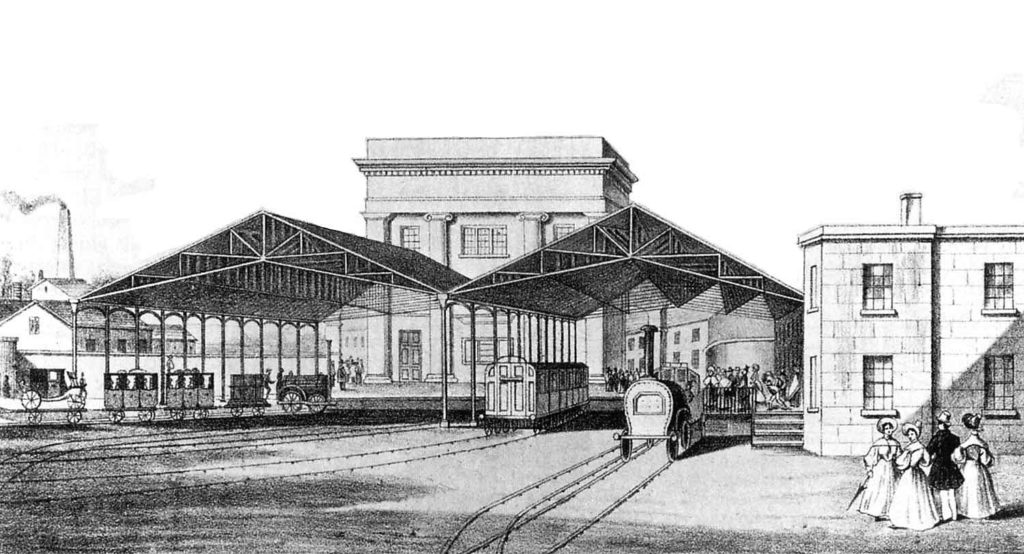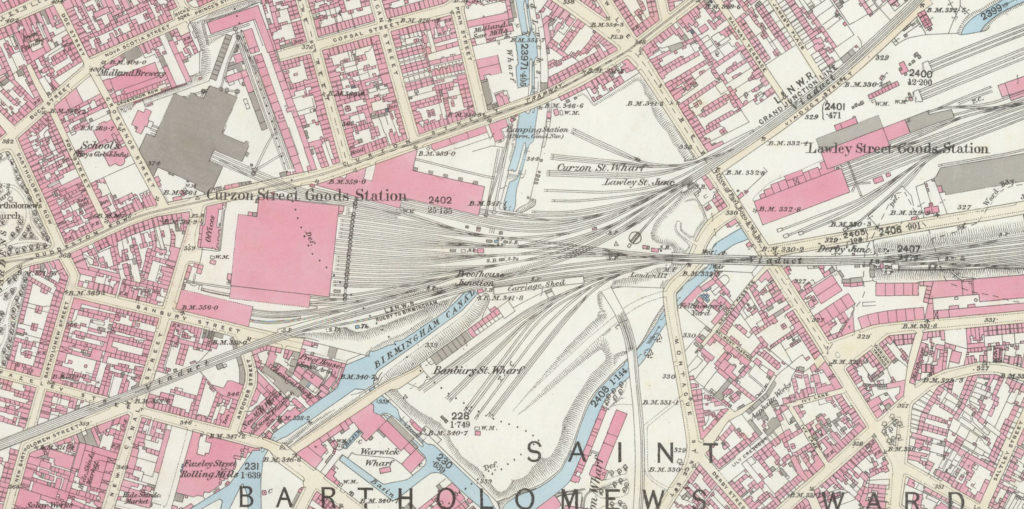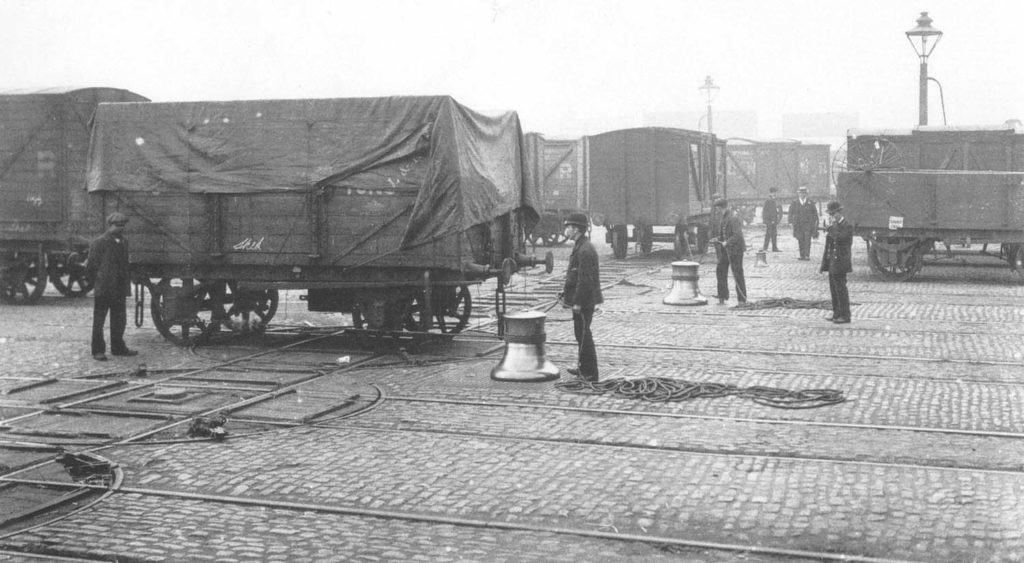The 112-mile-long London & Birmingham Railway (L&BR), engineered by Robert Stephenson, was the first inter-city line to be built into London. The Parliamentary Act authorising its construction was passed on 6 May 1833. At Birmingham it was to connect with the 82 miles Grand Junction Railway (GJR), authorised on the same day. Together these railways would provide a route from London via Birmingham to Liverpool and Manchester, connecting four of the most important cities in the country. Construction of the L&BR was the largest project ever undertaken in Britain, costing approximately £5.5 million at the time.
As Birmingham is on high ground, the L&BR and GJR stations were located at the eastern edge of the city on the south side of Curzon Street, in an area of market gardens and fields next to the Digbeth Branch Canal. The original intention was for the two railways to meet end on to facilitate operation of through trains. Unfortunately, opposition from influential landowners forced changes to the desired GJR alignment at Birmingham that resulted in two adjacent termini being built at Curzon Street. This created both inconvenience to passengers and operating difficulties for journeys between London and the North West.

The Grand Junction line reached Birmingham in July 1837 and ran trains to a temporary station at Vauxhall about a mile short of Curzon Street until the 28-span viaduct over the River Rea valley and their Curzon Street station was complete. The L&BR terminus opened on 8 April 1838. However, due to the delayed completion of Kilsby Tunnel, London passengers had to travel the 36 miles between Denbigh Hall (near Bletchley) and Rugby by horse-drawn coach or omnibus. The first through train from London to Birmingham entered the station on 17 September 1838 after covering the 112 miles in 4 hours and 48 minutes. Before construction of the railway, this journey was a bone shaking two-and-a-half-day ordeal. The GJR terminus opened soon after, on 19 November 1838.
The original stations
The L&BR station was built on the south side of the site with parallel arrival and departure platforms and six tracks. Four carriage sidings were between the two outer platform tracks. A train shed comprising two wrought iron truss spans covered both platforms and the six tracks. Booking offices, waiting rooms and a parcels office were in a long building along the back of the departure platform. An imposing three-storey ‘Principal Building’ with four massive Ionic columns designed to match the Doric Arch at the London terminus was erected at the entrance to the station that faced onto New Canal Street. This is now the only surviving part of the original station. It is the world’s oldest example of monumental railway architecture and is Grade 1 Listed.

The Grand Junction terminus was a more modest affair on a triangular area of land alongside Curzon Street, immediately north of the L&BR station. As shown on the 1846 plan, it was necessary for the arrival platform to be built beyond the end of the departure platform to fit the odd shaped site. The principal station offices were at the rear of the departure platform. Separate arrivals and departure yards were provided for passengers and their horse-drawn carriages between the station buildings and Curzon Street. An elaborate façade or screen wall was built between the station and Curzon Street to impress travellers and commemorate the construction of the GJR, another major feat of engineering.
L&BR carriage sheds, a sixteen sided ‘Engine House’, and facilities for transhipping goods between the L&BR and the Birmingham Canal were on the land to the south and east of the termini. Three tracks ran between the two stations to a level crossing that provided access to a L&BR Goods Depot on the north side of Curzon Street. By 1846 the train shed had been extended to accommodate longer trains. The departure platform had been extended to create a bay platform for the Birmingham and Gloucester Railway and the Principal Building at the station entrance had been extended on its north side to provide additional refreshment space for passengers. The building became the Victoria Hotel, later renamed the Queen’s Hotel.
LNWR days
The year 1846 is significant because it was when the L&BR and the GJR merged to form the London & North Western Railway (LNWR). One of their first decisions was to obtain an Act to build a larger through station closer to the centre of Birmingham to replace the Curzon Street station, which then was struggling to handle increasing traffic levels. This new station was built jointly by the LNWR and the Midland Railway between 1846 and 1854. When opened it was called the Grand Central Station but was later changed to Birmingham New Street. After the 1854 opening, all Curzon Street passenger services were transferred to New Street and the Queen’s Hotel was closed.
For several years, the old passenger station was used only as an overflow area for the goods depot that continued to operate on the other side of Curzon Street. However, from the mid-1850s rail freight volumes increased year on year making it increasingly difficult for the depot to handle the traffic. The LNWR converted the passenger station into their main Birmingham goods station. Work started in 1860 with closure of the Curzon Street engine house.

The train sheds were kept but the general station buildings were demolished. Conversion was completed in 1865 after which this depot remained in use with little change for more than a century, until its closure in 1966. One change, in 1874, altered part of the site at the corner of New Canal Street and Banbury Street to make an ‘excursion station’ for trains to Sutton Coldfield and Sutton Park and relieve New Street at peak holiday periods. This was used until Easter 1893 when it closed to enable the main lines into New Street to be increased from two to four.
The 1887 OS map shows the extent of the Curzon Street Goods Station. The grey building on the north side of Curzon Street is the original L&BR goods depot. It was combined with the main LNWR depot and known as the ‘Top Yard’.
The old passenger station’s Principal Building and hotel wing were retained as offices for the main goods station. They are clearly indicated on the map at the junction between New Canal Street and Curzon Street. The photograph on page 17 shows how they appeared in 1900.
Many horses were used for delivering goods to and from the depot. The stables and veterinary facilities for the horses were in the Top Yard. In 1914, the Curzon Street Goods Station employed more than 2,000 people together with 600 horses and 900 wagons. In the early years, horses were used to shunt wagons in the depot but capstans and turntables were also used to transfer wagons between tracks and marshal them into trains.
The depot handled a vast range of items of all shapes, sizes and weights. Fruit and vegetables went through the old GJR arrival platform train shed, while grain and flour were dealt with in the old GJR departure area. General merchandise was processed beneath the 1838 L&BR train sheds.
LMS, BR and HS2
After the Railway Grouping of 1923, ownership of the depot transferred to the London Midland & Scottish Railway (LMSR). During the Second World War the depot suffered bombing. An incendiary hit the Principal Building and other bombs fell nearby. Damage to the Principal Building was not severe. It was repaired and, in 1952, given Grade 1 Listing in recognition of its historical importance. Throughout the LMSR era and into the 1950s, when it was part of British Railways, the depot continued to be a hive of activity.

By the mid-1960s, migration of freight from rail to road changed all that, leading to the depot’s closure in 1966. Within a few years after closure, the platforms, train shed and the substantial remains of the GJR station had all been removed. The Principal Building was the only part of the old station to be spared. The goods station site was bought by Royal Mail who erected large steel-framed sheds and created a Parcelforce depot. A car park was built over the former GJR station land.
The Principal Building remained in British Rail ownership. It was left to decay. In 1970 and again in 1978, British Rail applied to demolish the Grade 1 Listed Building, but permission was refused on both occasions. Ownership of the building eventually transferred to Birmingham City Council in 1979. The Council carried out extensive restoration and repairs between 1979 and 1982. However, that work included demolition of the hotel wing, leaving only the original Hardwick designed edifice standing. The building was intermittently used as office space but now has been empty for some years.
By 2005 the Parcelforce depot was out of use. In 2006 the buildings were removed and the whole site became a car park. Five years on, the government in 2010 published their ‘National Strategy for High Speed Rail’, the first phase of which would be a new high speed line between London and Birmingham, and which recommended a new Birmingham city centre station at Curzon Street. The document also reported that the station offered an exceptional opportunity to restore the iconic Grade I listed frontage of the former Curzon Street terminus for railway use.
In November 2013, HS2 Ltd deposited a Bill with Parliament to seek powers for the construction and operation of HS2 Phase 1. The Bill became the High Speed Rail (London – West Midlands) Act 2017 after receiving Royal Assent on 23 February 2017. This Act authorises construction of Phase 1 between London and Birmingham and the station layout authorised under the Act states: “Old Curzon Street Station building and wall to be retained”. A later HS2 brochure has confirmed that, in addition to the new station, separate plans are being progressed to redevelop the Grade 1 listed building. It says the renovated building will house a visitor centre and office space that will be used by HS2 along with other organisations.
Once in place, the building will serve as a community engagement hub for HS2. If this happens, the building will serve the railway industry into the foreseeable future, and be a fitting and lasting monument to the first railway between London and Birmingham: the first main line railway into London, completed more than 180 years ago.
Hugh Fenwick is the Vice-chair of the Robert Stephenson Trust


